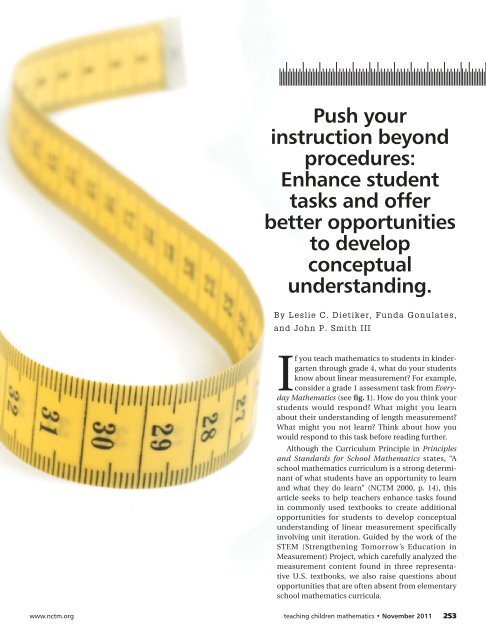Understanding Linear Measurement
Understanding Linear Measurement
Understanding Linear Measurement
Create successful ePaper yourself
Turn your PDF publications into a flip-book with our unique Google optimized e-Paper software.
Push your<br />
instruction beyond<br />
procedures:<br />
Enhance student<br />
tasks and offer<br />
better opportunities<br />
to develop<br />
conceptual<br />
understanding.<br />
By Leslie C. Dietiker, Funda Gonulates,<br />
and John P. Smith III<br />
If you teach mathematics to students in kindergarten<br />
through grade 4, what do your students<br />
know about linear measurement? For example,<br />
consider a grade 1 assessment task from Everyday<br />
Mathematics (see fig. 1). How do you think your<br />
students would respond? What might you learn<br />
about their understanding of length measurement?<br />
What might you not learn? Think about how you<br />
would respond to this task before reading further.<br />
Although the Curriculum Principle in Principles<br />
and Standards for School Mathematics states, “A<br />
school mathematics curriculum is a strong determinant<br />
of what students have an opportunity to learn<br />
and what they do learn” (NCTM 2000, p. 14), this<br />
article seeks to help teachers enhance tasks found<br />
in commonly used textbooks to create additional<br />
opportunities for students to develop conceptual<br />
understanding of linear measurement specifically<br />
involving unit iteration. Guided by the work of the<br />
STEM (Strengthening Tomorrow’s Education in<br />
<strong>Measurement</strong>) Project, which carefully analyzed the<br />
measurement content found in three representative<br />
U.S. textbooks, we also raise questions about<br />
opportunities that are often absent from elementary<br />
school mathematics curricula.<br />
www.nctm.org teaching children mathematics • November 2011 253


